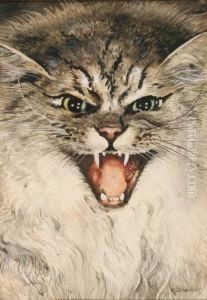Karoly Muhlbeck Paintings
Károly Muhlbeck was a Hungarian painter, known for his contributions to the art scene in Hungary in the late 19th and early 20th centuries. Born on March 10, 1859, in Moson (now Mosonmagyaróvár in Hungary), Muhlbeck showed an interest in art from an early age. He pursued his passion for painting by studying at the Academy of Fine Arts in Vienna, which was a leading institution for artistic training at the time.
After his studies in Vienna, Muhlbeck continued his education at the Academy of Fine Arts Munich, a city that was attracting a growing number of artists due to its vibrant cultural scene. Here, he was influenced by the works of the Munich School, which emphasized realism and a meticulous approach to detail. This influence would become evident in his own style, which often featured historical and genre scenes, as well as portraits.
Muhlbeck returned to Hungary and became an active participant in the local art community. He exhibited his work at various venues and was recognized for his skill, particularly in his handling of historical subjects. His paintings often depicted moments from Hungarian history, imbued with a sense of national pride and identity that resonated with the cultural sentiments of the time.
In addition to historical scenes, Muhlbeck was also known for his portraits. He had the ability to capture the personality and essence of his subjects, making his portraits highly sought after by the elite of Hungarian society. His work in this genre contributed to his reputation as one of the notable Hungarian portraitists of his era.
Muhlbeck's contribution to Hungarian art extended beyond his paintings. He was a respected figure among his contemporaries and played a role in shaping the art scene in Hungary. His commitment to his craft and his nationalistic themes in his historical paintings made him a significant figure in the cultural life of Hungary during his lifetime.
Károly Muhlbeck passed away on February 10, 1916, leaving behind a legacy that would influence future generations of Hungarian artists. His works can be found in various Hungarian museums and are considered an integral part of the country's artistic heritage.
